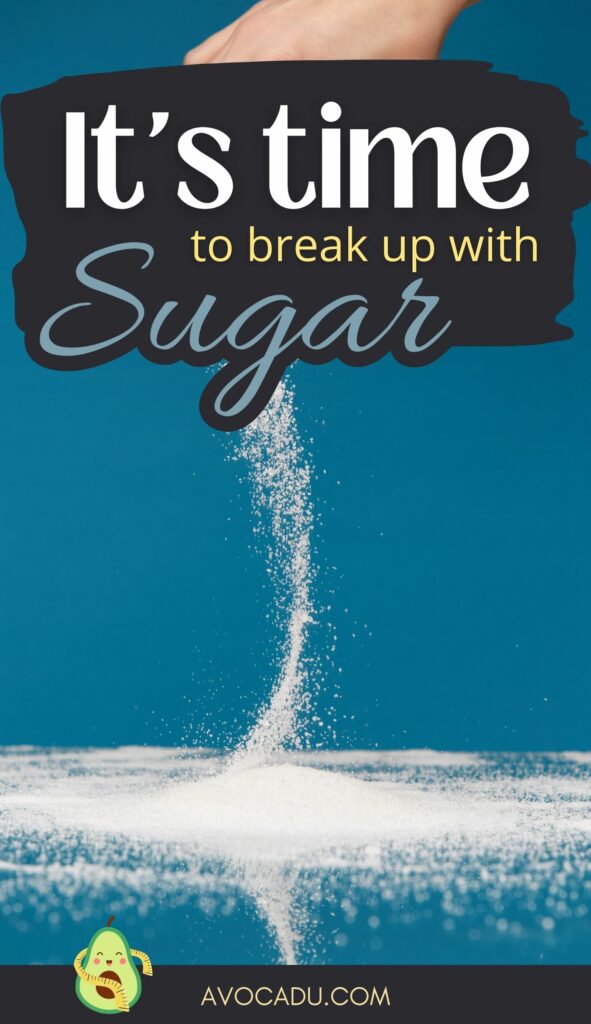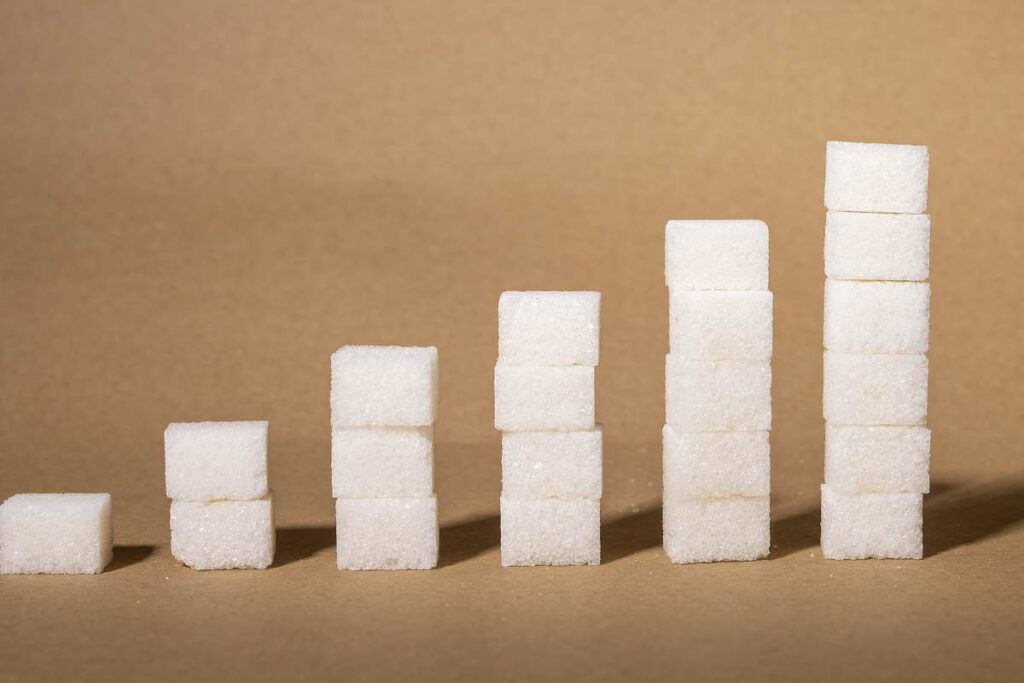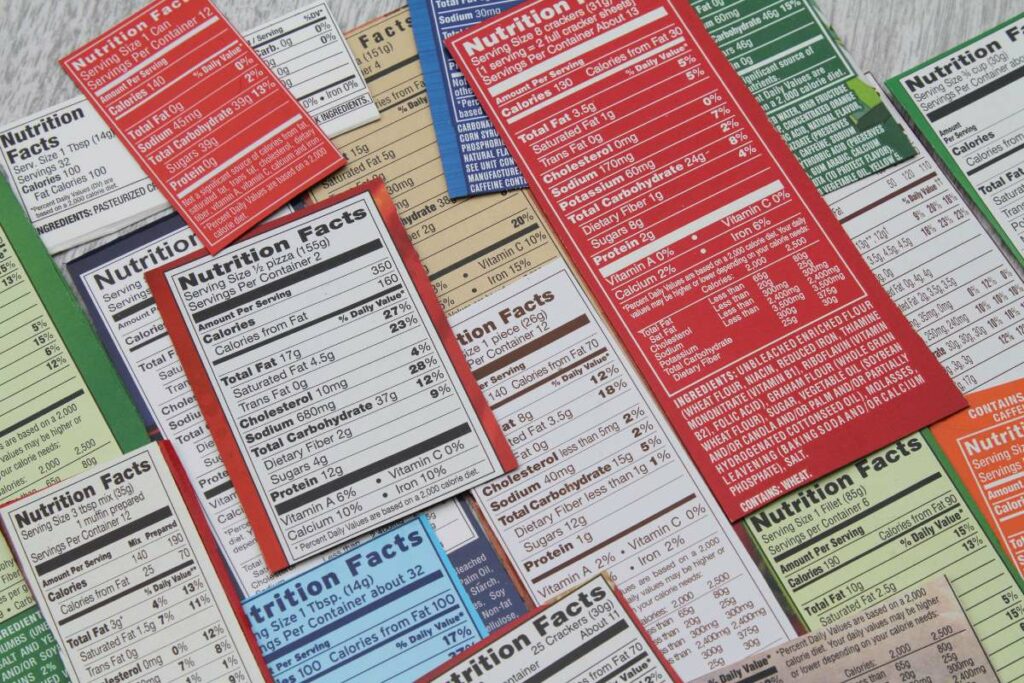Sugar Detox: Kicking The Sweet Temptation To The Curb!
In an era where sugar sneaks its way into almost everything we consume, the mere thought of cutting back may seem intimidating.
From the sugar-laden cereal that kick-starts your day to the late-night chocolate binge, sugar has established its reign. But, fear not! You can challenge the status quo by doing a sugar detox.

This post may contain affiliate links, which helps keep this content free. Please read our disclosure for more info.
What is a Sugar Detox?
A sugar detox is a conscious effort to reduce or eliminate the consumption of added AND natural sugars in your diet.
This includes not just the sugar you sprinkle over your morning coffee, but also the hidden sugars in processed foods, sodas, and even seemingly healthy options like fruit juices.
While nature’s own sweets, fruits, undoubtedly trump candies and sodas in the health department, it’s important to acknowledge that they still influence your blood sugar levels.
A Spoonful of History: The Rise in Sugar Consumption

Not so long ago, sugar was considered a luxury. However, as the 20th century rolled in, sugar became more accessible and cheaper.
In the US alone, the average consumption of added sugars has skyrocketed from 4 pounds per person per year in the early 1800s to over 100 pounds in the 2000s!
This sweet invasion has contributed to an increase in obesity, diabetes, and heart diseases.
Why Should We Detox from Sugar?
There are an abundance of reasons why cutting back on sugar can have profound effects on your health. Let’s dive into each of them:
Related Article: 3-Day Detox Diet Plan – Just 5 Ingredients
1. Weight Management
When you consume more sugar, your body has a surplus of energy. What it doesn’t use, it stores as fat.
By cutting back on sugar, you decrease your caloric intake and prevent unnecessary weight gain.
This not only helps in achieving a healthier weight but also makes it easier to maintain it.
Plus, reduced sugar consumption can help in tackling visceral fat, which is linked to various health issues.
2. Enhanced Energy Levels
Sugar might give you a quick burst of energy, but what follows is often a crash that leaves you more fatigued than before. This is because sugar causes a rapid spike and subsequent drop in blood sugar levels.
By detoxing from sugar, you stabilize these levels. This results in sustained energy throughout the day, making you feel more active and less reliant on sugar for a quick energy fix.
3. Improved Mental Clarity

High sugar intake affects cognitive function. The constant roller coaster of blood sugar levels can lead to brain fog, reduced attention span, and impaired memory.
There is a growing body of evidence suggesting that excessive sugar intake is associated with an elevated risk of neurodegenerative diseases, including Alzheimer’s.
Intriguingly, some experts have started to refer to Alzheimer’s as “Type 3 Diabetes” due to the observed connection between high sugar levels and cognitive decline.
Cutting back on sugar not only improves focus and mental clarity in the short term but may also have long-term protective effects on the brain.
4. Reduced Risk of Chronic Diseases
Sugar is a known culprit in the development of various chronic diseases. The most prominent among these are type 2 diabetes and heart diseases.
High sugar consumption contributes to insulin resistance, which can lead to diabetes. It also increases triglycerides, leading to heart diseases.
Some studies even suggest that excessive sugar consumption is linked to an increased risk of certain types of cancers. Reducing sugar intake is a proactive step in decreasing the risks of these chronic conditions.
5. Improved Skin Health

Wondering how sugar is linked to your skin? Glycation is a process where sugars attach to proteins, including collagen and elastin that maintain skin’s youthfulness.
This causes them to lose their functionality, leading to sagging and wrinkles. Additionally, sugar can also exacerbate inflammation which is believed to contribute to acne. By detoxing from sugar, you might notice your skin becoming clearer and more radiant.
Related article: Why You NEED a Carb Detox to Lose Weight
Bonus: Better Dental Health
Less sugar means fewer cavities! Bacteria in the mouth feed on sugars, producing acids that erode tooth enamel. This leads to cavities and other dental issues. Reducing sugar intake can lead to better oral health.
How to Do a Sugar Detox: A Step-by-Step Guide
Embarking on a sugar detox requires dedication and strategic planning. Let’s break down the steps to help you conquer this mission:
1. Set Clear Goals
Start by pinpointing what a “sugar detox” signifies for you. This could mean bidding farewell to all added sugars or simply scaling back.
Be precise, and make a note of your intentions. You may find it helpful to jot down why you’re doing this; whether it’s for weight loss, better skin, or general health.
2. Read Labels

Sugar has a knack for stealthily sneaking into packaged foods. Equip yourself by reading labels religiously.
Watch out for aliases that sugar goes by such as sucrose, high fructose corn syrup, and dextrose. You’ll be surprised where you find sugar hiding!
3. Clean Your Pantry
When cravings hit, easy access to sugary snacks is your worst enemy. Take control by purging your pantry of these temptations.
Replace them with healthier alternatives such as nuts, seeds, and low sugar fruits. This ensures when you need a snack, your choices are more nutritious.
4. Stay Hydrated
Often thirst masquerades as hunger. Drinking water can sometimes be all it takes to alleviate a sugar craving.
Make a habit of keeping a water bottle at hand and taking sips throughout the day. This simple habit can be a game-changer in your sugar detox journey.
5. Plan Balanced Meals
Satiety is key in reducing cravings. Meals that include whole grains, proteins, healthy fats, and fiber keep you fuller for longer.
When planning meals, think about including a balance of these nutrients. This will not only help in reducing sugar cravings but also ensure a nourishing diet.
6. Seek Support

There’s strength in numbers. Share your sugar detox goals with friends or family members who can offer support. If you don’t have support in your immediate circles, look for online communities or support groups.
Sometimes, just knowing you’re not in it alone can provide the motivation needed to stick with it.
7. Be Mindful of Emotional Eating
Cravings can sometimes stem from emotional needs rather than physical hunger. Recognize the triggers that make you reach for comfort in sugary foods.
This could be stress, sadness, or even boredom. Finding alternative ways to deal with these emotions, such as talking to a friend or engaging in a hobby, can reduce reliance on sugary treats.
8. Gradual Reduction
A sudden, drastic cut in sugar intake can be overwhelming. For some, a more sustainable approach might be to gradually reduce sugar intake over a few weeks.
This can be less shocking to the system and may help in adjusting to the new dietary changes more smoothly.
Beware of the Detox Symptoms
Brace yourself as you begin the sugar detox; you might face a few hurdles in the form of withdrawal symptoms.
These symptoms are similar to what one might experience during caffeine withdrawal. Let’s explore these symptoms and ways to alleviate them:
1. Headaches

A common symptom of sugar withdrawal is headaches. Your brain is accustomed to running on a high level of sugar, so when you cut back, it may protest in the form of a headache.
How to Alleviate: Drinking water can sometimes relieve a headache. Also, make sure you’re not hungry, as low blood sugar can also cause headaches. Gentle stretching and deep breathing exercises might also be helpful.
2. Fatigue
Feeling sluggish and low on energy is common when you first cut out sugar. Your body is used to relying on sugar for quick energy, and it needs time to adjust to burning fat for fuel instead.
How to Alleviate: Ensure you’re getting enough sleep. Also, engage in light physical activities such as walking or stretching to boost your energy levels naturally.
3. Cravings
Your body will likely crave what it’s missing – sugar. This is completely normal and probably the most difficult part of the detox to overcome.
How to Alleviate: Eat balanced meals to keep you full and satisfied. When you get a sugar craving, try eating a piece of a low sugar fruit or a handful of nuts. Drinking water or herbal tea can also sometimes curb cravings.
4. Mood Swings
You might experience irritability or mood swings as your brain adjusts to the decrease in sugar.
How to Alleviate: Engage in activities that boost your mood. This might be listening to your favorite music, talking to a friend, or practicing mindfulness meditation.
Also, make sure you’re consuming enough fibrous carbs to keep your mood stable.
5. Difficulty Concentrating

The brain uses glucose as fuel, so when you suddenly remove sugar, you might find it hard to concentrate.
How to Alleviate: It’s vital to eat regularly to maintain stable blood sugar levels, which in turn helps in concentration. Opt for meals and snacks that are high in protein, such as chicken, fish, legumes, and nuts, as protein is excellent for satiety and balancing blood sugars.
Incorporate low-carb veggies like spinach, broccoli, and bell peppers which are packed with nutrients without causing sugar spikes.
Also, don’t forget healthy fats like avocados, olive oil, and nuts, as they provide sustained energy and are excellent for brain health. Balancing these nutrients will offer your brain a steady source of energy without relying on sugars.
Bonus: Electrolytes to the Rescue

During the initial phase of a sugar detox, your body may excrete more water, and with it, electrolytes. This can exacerbate some of the symptoms like headaches and fatigue.
How to Alleviate: Consume foods high in electrolytes or consider an electrolyte supplement.
Some good sources of electrolytes are avocados, nuts, seeds, and leafy green vegetables. Drinking bone broths can also be beneficial.
In Conclusion
A sugar detox is far more than a mere dietary adjustment; it’s akin to making a deposit in the bank of your long-term health and well-being.
This invigorating voyage stands to bestow upon you a plethora of advantages, encompassing the physical, mental, and emotional spheres.
The transformative potential of bidding adieu to excessive sugar is immense. So, muster up the courage, take the leap, and let the natural richness of life sweeten your days!
A Door to Further Transformation: The 21-Day Fat Loss Program
As you embrace the sugar detox, you might be wondering what next? How can you continue to build on this foundation for a healthier lifestyle?
The 21-Day Fat Loss Program can be your next step. This program focuses on effective fat loss through a combination of strategic eating patterns, exercise, and lifestyle adjustments.

It’s designed to help you shed those stubborn pounds, rev up your metabolism, and achieve a leaner, more energetic self.
The best part? It builds on the principles of clean eating and balance that you’ve started with your sugar detox.
Consider the 21-Day Fat Loss Program as a turbo-boost in your ongoing journey towards an enriched and vibrant life.

